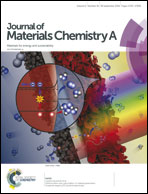Converting detrimental HF in electrolytes into a highly fluorinated interphase on cathodes†
Abstract
A highly fluorinated cathode–electrolyte-interphase is constructed on a Li-rich transition metal oxide via a unique additive approach, which significantly improves the cycling stability of Li-ion batteries based on such a high energy density cathode material. Physical characterization and electrochemical measurements aided by theoretical calculations reveal that the silane molecule with an unsaturated functionality effectively scavenges harmful hydrogen fluoride (HF) from the electrolyte and forms a complex, which undergoes preferential oxidation on the cathode surface in the initial charging and eventually delivers the fluorine species to the interphase. This understanding of the fundamental relationship between the additive structure and interfacial chemistry provides inspiration for the rational design of more effective electrolyte additives for more aggressive next-generation battery chemistries.



 Please wait while we load your content...
Please wait while we load your content...